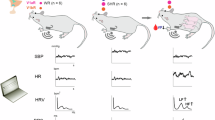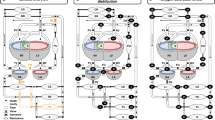Abstract
ABSTRACT: The present study was designed to determine whether the often observed gestational rise in blood volume alters the hemodynamic response to volume stress relative to the nonpregnant state. Late-pregnant and nonpregnant Wistar rats, prepared with an electromagnetic flow probe around the ascending aorta and/or intravascular catheters were used for this study. One of the following sets of measurements were performed either before and after volume loading or before and after volume depletion (24 h thirst): 1) continuous monitoring of cardiac output, blood pressure, heart rate, and fluid balance (only during volume loading); 2) measurement of cardiac output and regional blood flows (microspheres); and 3) measurement of the inferior vena cava diameter (x-ray). Both rapid (bolus) and slow volume loading (infusion) led to a rise in cardiac output. The generated surplus in cardiac output was distributed to the kidneys, skeletal tissues, and intestines (only in nonpregnant rats), and was paralleled in the pregnant rats by a consistent fall in placental blood flow. Slow volume depletion had neither a consistent effect on cardiac output nor on its distribution, with even a preserved maturational rise in placental blood flow during the 24 h of thirst. Slow volume loading and depletion led to an increase and decrease of the caliber of the inferior vena cava, respectively. The nonnuterine hemodynamic response to all forms of volume stress had not changed in pregnancy. The results of this study suggest that the hemodynamic response to volume stress consists of three components: 1) a venous response that dampens with a certain lag time the effects of volume changes on venous return; 2) an instantaneous response of the volume regulatory system, which includes a change in renal perfusion; and 3) an effect on venous return and, with it, cardiac output that only develops when the veins are unable to buffer imposed volume changes. If the latter causes systemic flow to increase in excess of nutritional demands, the surplus flow is shunted through small arteriovenous shunts in skeletal tissues (and intestines in nonpregnancy), to protect the systemic capillary bed. Massive systemic shunting on top of an already congested venous compartment can be expected to raise mean circulatory filling pressure. It is speculated that the latter causes the selective decrease in placental flow after volume loading through a direct negative effect on the peculiar (rat) placental microcirculation.
Similar content being viewed by others
Log in or create a free account to read this content
Gain free access to this article, as well as selected content from this journal and more on nature.com
or
Author information
Authors and Affiliations
Rights and permissions
About this article
Cite this article
Boekkooi, P., Janssen, B., Verkeste, C. et al. Hemodynamic Response to Volume Stress in Awake Late-Pregnant and Nonpregnant Rats. Pediatr Res 30, 479–486 (1991). https://doi.org/10.1203/00006450-199111000-00016
Received:
Accepted:
Issue date:
DOI: https://doi.org/10.1203/00006450-199111000-00016



